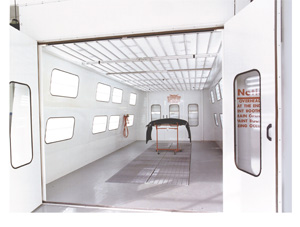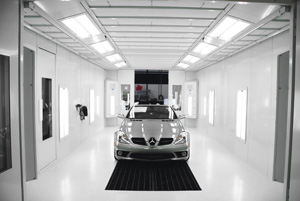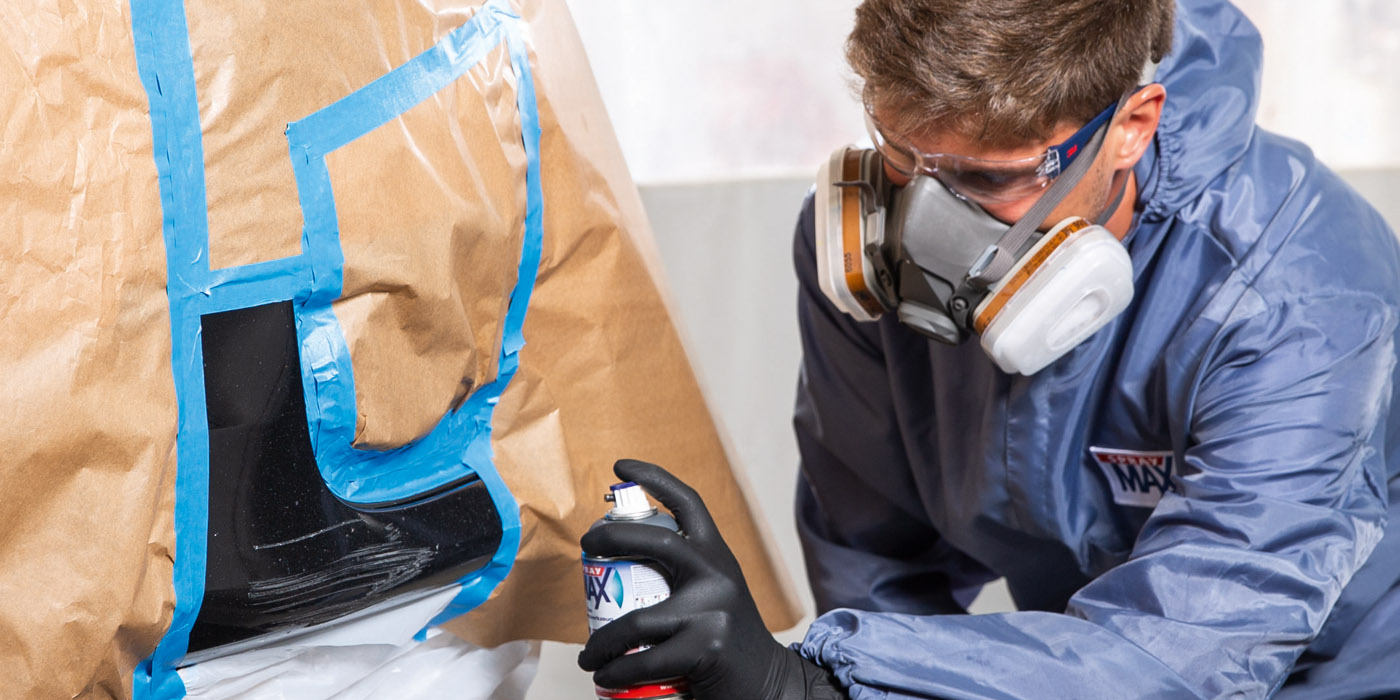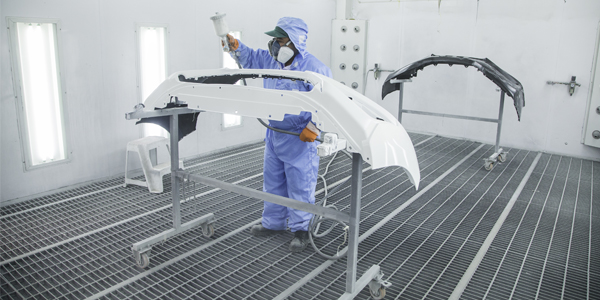Home makeover shows are all the rage on television these days. I’m sure an interior designer would have some more colorful ideas to refurbish your spraybooth than I’ve been able to uncover for this article. After all, there’s nothing intrinsically attractive about a 24-foot-long steel box with a giant fan.
While shades of fuchsia and apricot may be the height of fashion in the pages of Vogue, it’s hard to beat plain ol’ white for reflecting lots of light inside the booth. Strategically placed knickknacks no doubt spice up the living room, but any extraneous items inside the booth cabin just collect dirt.
So if a colorful interior decorator can’t help, how would your shop prepare the paint department for waterborne coatings?
The Waterborne Wave
As a quick review, water came to be a carrier for automotive finishes because the South Coast Air Quality Management District (SCAQMD) in Southern California enacted regulations that said anyone spraying paint within its jurisdiction must use products that minimize air pollution. Rule 1151 amendments call for automotive clearcoats with no more than 2.1 pounds of volatile organic compounds (VOC) per gallon of clearcoat, and basecoats must contain no more than 3.5 lbs./VOC. While most current 2.1-lb. compliant clearcoats reach conformity with traditional solventborne, isocyanate-catalyzed chemistry, basecoat colors from many paint manufacturers have elected to employ water as a solvent (no VOCs) to achieve the 3.5-lb.-per-gallon maximum VOC content.
Waterborne finishes dry by the coalescence of the paint film rather than evaporation of the petroleum solvents. Water doesn’t have the same proclivity to evaporate out of the paint film as lighter-than-air petroleum solvents do. Many productive body shops have employed some method to blow moving air across the paint to cause the water to evaporate quickly.
Regulations to clean up our air quality nationally are in the works in many states outside of California. To my knowledge, 18 states have indicated that they’ll enact similar VOC limits for auto body painters. Many shops in non-regulated areas see an advantage to promptly adopting the latest in waterborne basecoat technology. Waterborne chemistry may soon be coming to your neighborhood.
Compliant color offerings from many paint companies provide improved color match because water is a one-speed solvent, and the huge variance in color appearance due to faster or slower solvent evaporation speeds in metallic and pearl colors is eliminated. Waterborne resins tend to be very clear and offer the same bright, clean-looking colors that car manufacturers produce when they apply their waterborne finishes at the factory. Dry speeds can be faster than solvent in the right conditions, so shops could enjoy an increase in throughput and production. Many shops also believe they’ll benefit marketing-wise by promoting themselves as environmentally conscious and "green" to consumers who value clean air.
Air Speed
This finally brings us back to the spraybooth "makeover" necessary to enjoy all the advantages of a compliant, waterborne basecoat system in your shop. As I see it, the issues include finding a method to move air across the drying paint film to drive the water out quickly and a plan to keep the finish clean and free from all the dirt that the extra moving air could blow into the paint.
Depending on the volume of repairs processed through the shop, the moving air in the shop’s existing booth may work just fine with waterborne. I contend the median body shop in the U.S. does about $750,000 worth of collision repairs each year. Half the shops do more, half the shops do less. At these annual sales, the shop would paint only two cars per day. As long as the current spraybooth has air moving through it at NIOSH-legal speeds (75 to 100 feet per minute,) the water will leave the paint film quickly enough to allow the shop to paint one car in the morning and another in the afternoon.
Remember that the air speed in the booth cabin is dependent not only on the fan diameter and motor RPM but on the condition of the intake and exhaust filters, too. Clogged filters will slow the air speed down dramatically. Changing both the incoming filters (which plug with dirt and dust from outside the booth) and the paint arrestors (which plug with overspray created inside the cabin and trapped on the way out of the booth) on a regular basis will create the cleanest, safest and most productive conditions – no matter what kind of paint your shop shoots.
Upgrade or Retrofit?
Shops that paint more than two or three vehicles per day may find that some waterborne finishes require more moving air to dry productively fast. At that point, the choices are to upgrade to a new spraybooth or retrofit the existing one with auxiliary air movement.
A new booth will have the latest in filter technology – filters with more airflow capacity and finer mesh at the same time. A new booth will have the most versatile and productive control panels to easily adjust the heat, recirculation, airflow and exhaust speeds. A new booth could cost as much as $70,000, plus installation. On the other hand, the annual energy savings and the increased productivity could allow you to recoup the entire investment in a couple years. If you intend to spend 25 percent of the cost of a new booth on hot-rodding your old one, you should fully investigate the cost and payback for a state-of-the-art, brand-new spraybooth. It might be your best alternative.
However, this story is about a booth makeover, so we’ll proceed as if you haven’t done your due diligence on acquiring and installing a complete brand-new spraybooth and decided instead to move more air in your existing one.
Accelerating the air speed can be accomplished by spinning the air replacement furnace fan and the exhaust fan faster, installing additional bladed fans in the spray cabin, installing cabinet modules with adjustable jet nozzles or running compressed air through an air-multiplying venturi device. In each case, the retrofit will blow more moving air across a waterborne finish, driving out the water within the paint film.
Depending on the chemistry employed by your paint manufacturer to construct a compliant coating of 3.5 lbs. or less of VOC, moving more air may be the only way to increase, or even maintain, high paint production output. As mentioned earlier, painting two or even three cars per day may not require any changes in your existing spraybooth other than to ensure the filters are fresh and the cabin is extra clean. But a $2 million shop will paint five or six cars each day, and thus is likely to need some equipment changes to enjoy its current throughput when it switches
to waterborne.
Fire Up the Furnace
One school of thought says that driving water out is best done by blowing more air through the existing equipment – increasing the RPM of the air replacement furnace (air makeup unit) to push more than the typical 10,000 to 12,000 cubic feet per minute (CFM) air volume out of the unit. Some newer high performance A/R furnaces can move 20,000 CFM. A new pulley may be able to increase the existing output by another 5,000 CFM. Other A/R changes could possibly increase the air speed as well, from the current 75 to 100 feet per minute (FPM) to as much as 200 FPM. While either method provides way too much air to paint with, those vendors say increasing the air volume and/or the air speed will serve to quickly get rid of the water in the paint film.
Air replacement furnaces can be either direct fired or indirectly heat the incoming air. A direct-fired unit uses big gas-fed burners to immediately heat the incoming 10,000 to 20,000 cubic feet of air by as much as 120º F. An indirect furnace uses the fuel gas to heat a core (like a radiator) and blows the incoming air across the hot core.
Burner relays can be electronic or motor-driven, have static or variable frequency drives, and differ in many other ways. Each style has its own proponents: direct-fired units are fast, indirect units are more economical to operate. But everyone agrees that high-quality, high-capacity intake filters will help move more air.
Most systems use at least two sets of filters: one to clean the incoming air before the furnace heats it and another to thoroughly clean the heated air before injecting it into the spray cabin. While many shops try to save money on the expensive intake filters, it’s a very poor economy. Not only will they sacrifice the even distribution of air throughout the cabin (downdraft booths work because of the "air balancing" filter pads), but cheap filters let more dirt particles through and can collapse at high air volumes or air speeds. Spend the money for top quality filters to make any spraybooth work best.
Disrupt the Airflow
In either a downdraft or crossdraft automotive spraybooth, the air moves across the vehicle in one direction: from top to bottom in a downdraft, and from front to rear (or vice versa) in a crossdraft. All auxiliary air movement devices serve to break up the linear airflow by interrupting the directional flow and moving the extra air in another plane. Several of the vendors I interviewed for this article told me to picture the smoke racing across the car in a wind tunnel. There’s a boundary layer of slower air right next to the vehicle surface; the smoke doesn’t appear to touch the car. Retrofit auxiliary air movement devices endeavor to interrupt the air moving in one direction and create some surface turbulence. These vendors say it’s exactly what’s required to get the water to leave the paint film.
Whether the additional air comes from bladed fans, turbine fans or adjustable nozzle jets, the extra air will disrupt the surface of the drying paint film and open it up, allowing the water to escape. In addition, these retrofit devices serve to mix the air inside the spray cabin effectively, meaning the heated air is evenly distributed around the vehicle.
Heat is still an important component of productive refinishing. Not only do solventborne undercoats and clearcoats require heat to dry and cure quickly, waterborne benefits from hot air to help bake out the moisture, too. Spraybooths are warmer at the top where the hot air is discharged from the furnace; air recirculation controls or auxiliary air movers assure a warm and even temperature by the lower body panels, making for quick and thorough dry times on bumpers and rockers.
Fan vendors have specific recommendations about where their units should be mounted within the booth to achieve optimum results: through the filter pad in the center of the intake plenum, in the four corners of the cabin or in the far front and rear center. Nozzle jet vendors also have firm opinions about where to install their units. Mounted either perpendicular or horizontal to the booth floor, they want to be able to direct their eyeball nozzles (swivels like your eye) to every part of the vehicle to concentrate the air velocity.
Each vendor claims that following their directions to the letter will ensure the cleanest air and fastest dry – which brings up one of the most important points in this story: Any shop intending to spend thousands of dollars on spraybooth improvements needs to establish a real partnership with both its paint company and equipment vendor.
Do Your Homework
Each paint manufacturer has the best knowledge about its specific chemistry. While all the paint offerings may comply with the 3.5-lb. VOC regulations, how each manufacturer achieved that differs substantially from brand to brand. Ask your jobber salesperson and paint brand rep first for their suggestions about moving more air. Based on which method of moving more air they suggest, locate several vendors that specialize in that type of system. Gather literature from them that explains how the air will be accelerated, where their units mount in the booth, what sort of energy is consumed in operation, what type of control panel is included (or optional) with the system, who will do the installation and how long the installation will take. Armed with this information, ask the finalist vendors for a list of reference shops that are currently using their products. If possible, visit a shop or two and witness the unit in routine operation.
Control panels can adjust numerous variables: which units are on, how much air they expel, when the A/R furnace kicks in and how hot it gets, whether heated air is exhausted or re-circulated, pre-set profiles for certain repairs or none of the above and a simple puffer switch to select between "on" and "off." Seeing the system in operation in a real shop will go a long way toward understanding whether a control panel with 50 variables is a good thing or a bad thing. Pitfalls abound; make sure you see live units. Everyone’s solution looks good on paper and, of course, every salesperson has the absolute best system on the market.
More Dirt
Contamination control becomes more important when you blow more air around the car.
Several equipment vendors claimed their units don’t contribute excess dirt to the finish because their airflow’s kinetic energy slows by the time it gets toward the floor and gets caught in the exhaust airflow. While I’m willing to concede that some units cause less dirt than other designs, common sense says if you blow more air around the car, more dirt will be blown into the ambient air, with an opportunity to land on the fresh finish. Dirt specks are much more visible in most waterborne finishes because the mil build is less. In other words, waterborne resins hide quickly, and the color coat is thinner than the regular solvent basecoats. Dirt problems are exacerbated by waterborne.
Good old fashioned booth maintenance is the best place to start. Pressure wash the intake and exhaust duct work, scrape and clean the exhaust pit, even tack wipe the intake plenum. Establish a firm filter change schedule and stick to it. Change the intake filter sets (A/R pre-filter and ceiling/door filter set) every so many repair orders. If you set a replacement schedule by time, some weeks you’ll paint more cars than other weeks; keep track of how many bake cycles or how many cars went through the booth to get a reliable interval.
While on the subject of minimizing dirt, I hear there’s a nifty new product on the market that’s basically dirt-trapping wallpaper for your booth. The theory is that the dust blown into the air will adhere to the gummy coating, keeping it away from the vehicle.
While thorough and regular cleaning costs labor time, it’s quickly made up in the time saved in re-work. One leading industry source calculates that most shops spend 20 to 40 minutes cleaning the particulate specks out of each paint job. If a clean spraybooth, a spray-suited painter and a water-rinsed vehicle could save half that time, it would show up as profits quickly. Common sense things like no sanding inside, wearing clean spray suits, thoroughly washing cars and no buffing in front of the booth make a huge difference.
Dirt has been a body shop nemesis since the first Model T got repainted black. High-hiding new paint chemistry just makes an old problem worse. Far too many shops knowingly don’t clean up, figuring they have to scuff and polish the car anyway. Those shops that have switched to waterborne basecoats can testify that time spent keeping the dirt out of the paint is saved many times over on rework.
No Single Answer
There is no single solution to this issue. Not all waterborne finishes require the same things to work productively. The first thing might be to form a good partnership with your paint company and then loop in your equipment vendor. Answer these questions:
• How many cars do you currently paint?
• How many cars you would like to paint?
• How much time do you spend on rework now?
• What will be the energy costs to operate the new devices?
No magazine article can address the specific things your location, production efficiency, technician skill sets and paint brand will dictate. Dynamic solutions are required; no one system fits all shops.
One piece of good news is that more moving air, even heat distribution, adjustable spray parameters and clean environments will benefit solventborne paints, too. Even if your shop is in an area that’s years away from mandating low-VOC basecoats, you can prosper today from effective air movement and making a clean spraybooth a high priority.
Writer Mark Clark is a well-known industry speaker and consultant. He’s celebrating his 22nd year as a contributing editor to BSB. While thorough and regular booth cleaning cost labor time, it’s quickly made up in the time saved in re-work.














